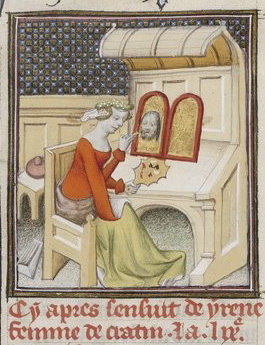Greeks but much more foreigners when thinking of ancient Greek culture, associate it almost exclusively with male historical figures. Indeed, the position of the majority of women in ancient Greece was at home. However, there were some women who, breaking the status quo of the time, dealt with creative areas of the human spirit, thus gaining an important place in the history of human civilization.
Since I personally love the art of painting, I would like to mention briefly, in the first phase, some Greek women artists who were distinguished in this field in antiquity.
So, let's begin with Alexandra.
Alexandra was the daughter of the Greek painter, Neokles and lived in the 3rd c. B.C.. She was trained in painting by her father, who was usually painting mythological subjects. In 1994 her name was given to the big crater of planet Venus, "Anaxandra".
Aristarete was also an painter's daughter. Her father was Nearchos but her mother is unknown until today. She lived in the archaic era, meaning in the 6th c. B.C..
The author Pliny attributes to Aristarete the painting depiction of the medical god Asclepius, which was located in the Asclepieion of Sikyona. Researchers assume that she used to paint mythological subjects.
Clement of Alexandria refers to her as follows: "Women are as capable as men to reach perfection."
Eleni lived in the 4th century BC. and it is noteworthy that she took part in the campaign of Alexander the Great in the east, among the intellectuals and artists who followed him. Her famous fresco was the one depicting Alexander the Great defeating Darius at the battle of Issus. It is even speculated that the well-known mosaic of Pompeii with the same theme is a copy of Eleni's work.
Irene lived in the hellenestic period, in the 3rd c. B.C. and was also a painter's daughter. Her father was Kratinos. It is known that an art work of hers was in Eleusis and was presenting a young woman.
Iaia or Lala was from Kyzikus and lived in Rome in the 1st c. B.C.. She was a great artist and painted with the techniques of tempera and caustic on ivory. She mainly painted portraits. Her best-known works are a self-portrait with a mirror and a portrait of an elderly lady. These paintings are now in Naples.
Pliny wrote that no one had a faster hand in painting than Iaia and that her fees exceeded those of the most famous painters of her time, Sopolis and Dionysius.
The paintress Kora (6th c. B.C..) was also the daughter of an artist and her life is associated with a beautiful and romantic story. She once fell in love with a young man who was about to leave the country. Then she drew the outline of the shadow of his face on the wall, which was was created by the light of a lamp. Her father filled the outline of the shadow with clay and baked it in the oven. So he created a clay pendant. The imprint of the relief was kept in Nymphaeum, until Mommios destroyed Corinth (146 BC).
Olympias was a painter of the 3rd century BC. She is known by Pliny as the teacher of the painter Autoboulos.
Timareti was a paintress of the archaic era and the daughter of the artist Mikon. She was usually illustrating vases and plates but was also helping her father with his frescoes. The painting of Artemis in Ephesus is attributed to her.











No comments:
Post a Comment